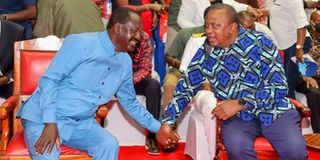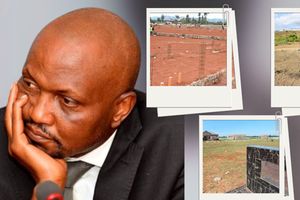Premium
Raila in a familiar quandary with Handshake, BBI, Azimio

President Uhuru Kenyatta with Azimio La Umoja flag-bearer Raila Odinga during the coalition’s National Delegates Conference at KICC.
What you need to know:
- The Handshake, BBI and Azimio confound their backers and opponents alike.
- Similarly, it is hard to say for certain what Azimio is, and what it is not.
In examining both the ‘grand statecraft’ and ‘subsistence politics’ of the Handshake-BBI-Azimio sequence, we find compelling ground to surmise that Raila Odinga has once again run into a familiar and insurmountable political problem in his quest to succeed Uhuru Kenyatta as President. As in 2002 and 2012, Odinga’s nightmare is Uhuru Kenyatta.
Does this necessarily imply that Odingan stands grounded as a redundant and, therefore, decommissioned political equipment? Not at all; Odinga remains a capacious entity with prodigious potential to unlock stupendous possibilities.
The Handshake, BBI and Azimio confound their backers and opponents alike. None can give a rational account of what the BBI was all about. If it was about national unity and inclusion, it was equally divisive and ultimately not all-inclusive. A number of inimical proposals were clearly not up for debate, and the coercion, extortion and outright bribery enlisted to advance them justified tremendous doubt and misgiving that eventually encumbered the entire enterprise.
Similarly, Azimio. It is hard to say for certain what it is, and what it is not. Expressed in the anomalous formulation of ‘coalition political party’, Azimio may also be ODM’s presidential campaign platform, or a stand-alone coalition backing Odinga.
It might also be a staging post where runaway political formations are yoked and tethered to clear the field for ODM and Odinga. But there is also compelling evidence that Azimio is the political sanatorium where Kenyatta has assembled bureaucratic surgeons and political nurses to rehabilitate a depleted, discredited and all but expired Jubilee.
Grand statecraft narrative
Given this raging identity crisis, it is understandable that would-be ‘principals’ or constituent parties and coalitions would evince much eloquent discomfort and graphic disorientation as the infinitely permuting comings and goings of Wiper, OKA and Mwanzo Mpya have.
Clearly, the now familiar, ham-fisted expression of Kenyatta’s preferences, first encountered in BBI, would account for much of Azimio’s behavior and outlook. Only Kenyatta appears to be equanimous, if not positively insouciant about this perturbing state of affairs. So what on earth is Azimio, and what might its purpose be?
The answer draws our attention to a political secret Kenyatta has succeeded in keeping hidden in plain sight. A persistent element of his grand statecraft narrative is a emphatic and determined recital, like a mantra, of peace being the fundamental rationale of the Handshake. By peace, Kenyatta sometimes appears to allude to reprieve from Odinga’s relentless onslaught on his administration, and Odinga’s followers’ immense disdain for Kenyatta.
This perception is fallacious, because it exaggerates Odinga’s political effect while underestimating Kenyatta’s imperious grip on power demonstrated by command of government, from Parliament to the county executives and assemblies.
Still, what explains the fact that peace and, therefore, unity, inclusion and all those nice things were centered as the lifeblood of BBI? We need an account that connects the Handshake, BBI and Azimio — incongruent as they seem — into coherent political reasoning. To arrive at this account, we must revisit a couple of recent events, in the light of descriptions offered here a fortnight ago.
Odinga’s ‘attempted assassination’
To recap, Kenyatta is the pivotal nucleus of concentric political constituencies: Jubilee and Mt Kenya. Kenyatta putative patrimony typifies and represents a conservative, arch-reactionary oligarchy. Odinga, for his part, is the kernel of an Odingaist movement and the linchpin, through ODM, of a leftist coalition forged out of the convergence of anti-establishment energies with the Odingas’ long-standing grievances.
These descriptions are necessary to appreciate how Kenyatta and Odinga understand themselves and their place in the Kenyan state and its politics. By this light, the Kenyan state is defined and underpinned by the titanic saga of the first Kenyatta and his counterpart, and now perpetuated by their heirs. Kenyatta insists that his handshake with Odinga was an existential imperative for the state, and that future politics and institutions must be predicated on this détente.
Responding to the stoning of Odinga’s helicopter in Uasin Gishu a fortnight ago, Kenyatta was clear that any injury to Odinga would have triggered Kenya’s ultimate implosion. Earlier this week, both Kenyatta and Odinga staged publicised interventions in the fuel shortage crisis that were clearly intended to be effective and conclusive. Kenyatta ceremoniously signed a momentous-looking instrument, ostensibly to unlock billions of shillings, while Odinga summoned oil marketing companies to a consultation to resolve the crisis.
Both spectacles came to nought, and the crisis raged forth. Odinga’s ‘attempted assassination’ case collapsed in court for lack of evidence. But none of that matters. What is important is that the duo deftly exploited national crises to project themselves as indispensable national institutions whose will defines our state and the destiny of 50 million people. Legal frameworks still struggle to catch up with the Handshake and its consequential formulations. The Kenyatta-Odinga dynamic, is presented as a supra-constitutional political artifact that gives Kenya its ultimate norm: the grundnorm.
Mr Ng’eno is an advocate of the High Court and a former State House speech writer. @EricNgeno





